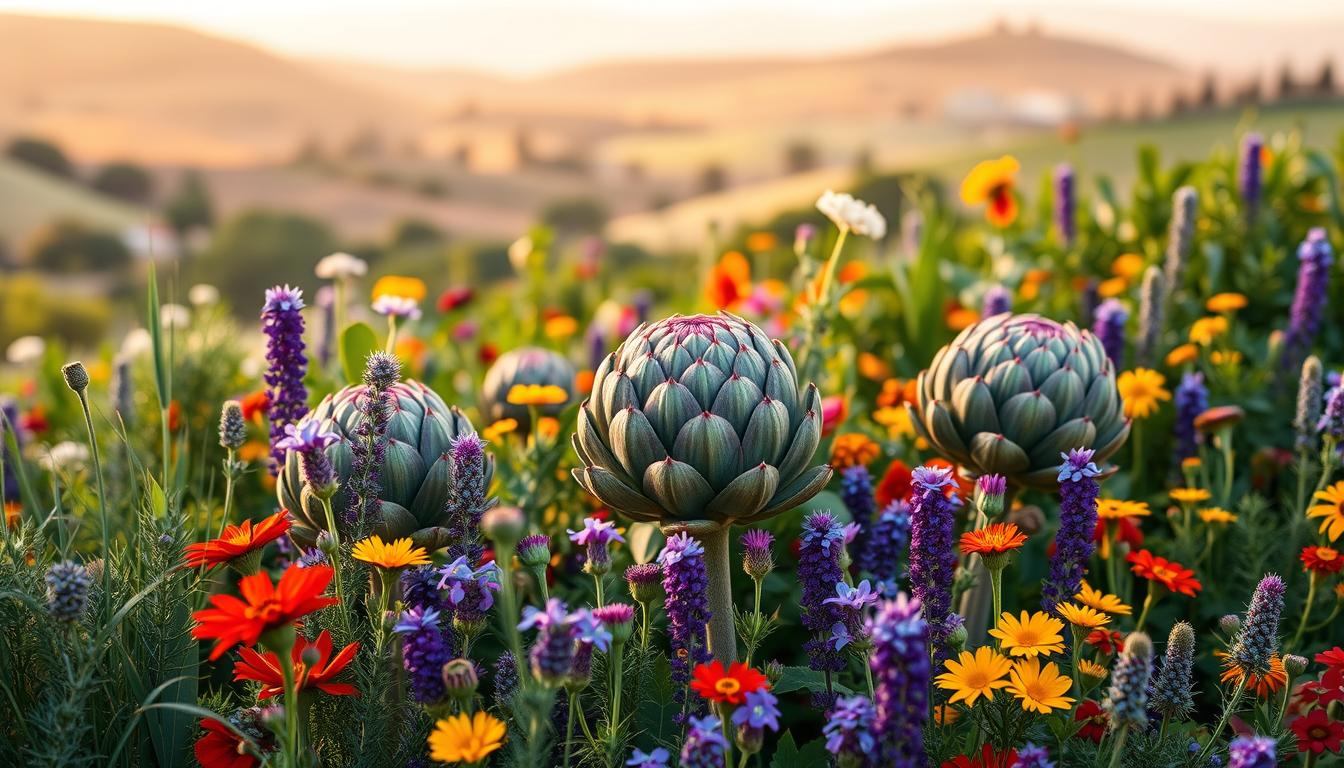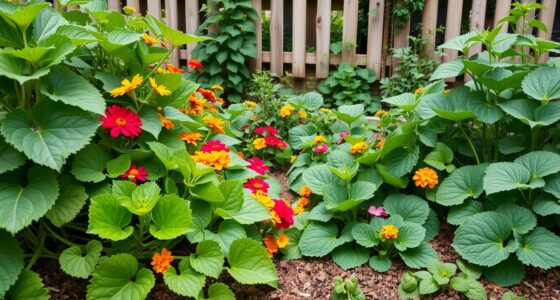Imagine stepping into your garden and being greeted by the tall, elegant stalks of artichokes, their buds standing proud as a testament to your hard work. These unique plants not only need care but thrive best when they’re part of a community, sharing space with companion plants for artichokes that enhance their growth and protect them from pests. This guide is your gateway to discovering the best companion plants for artichokes, revealing an artichoke companion planting guide that is as rewarding as the harvest itself. By inviting the right friends into your garden, you can cultivate health, flavor, and resilience in your artichokes while creating a vibrant ecosystem right in your backyard.
Let’s explore how combining your artichokes with the right plants can lead to a flourishing garden where every element complements another, promoting not just a bountiful yield but also a deeper connection to the natural world.
Key Takeaways
- Artichokes thrive in a community of companion plants that can enhance their growth.
- Choosing the right companions is crucial for pest control and soil health.
- Effective companion planting can lead to richer flavors in your artichokes.
- Planning your garden layout with companion plants boosts overall productivity.
- Maintaining artichokes alongside their companions helps in sustainable gardening practices.
Why Companion Planting Matters for Artichokes
Companion planting plays an essential role in creating a thriving garden ecosystem. When it comes to artichokes, the benefits of companion planting become even more pronounced. This technique not only improves the health of your artichokes but also leads to enhanced flavors and effective natural pest control solutions.
Benefits of Companion Planting
Implementing companion planting for artichokes allows you to optimize the growth potential of these remarkable plants. Pairing artichokes with the right companions can lead to increased yields, healthier plants, and improved flavor. For instance, certain plants can provide shade, protect against wind, or even enhance nutrient uptake. The synergistic effects create a harmonious environment where all plants can thrive.
Enhancing Growth and Flavor
The restorative effects of companion planting can significantly enhance the growth and flavor profile of your artichokes. When grown alongside compatible species, artichokes can experience less competition for resources like sunlight and nutrients. This not only boosts their growth rate but also enhances the final taste of the harvested buds.
Natural Pest Control Solutions
One of the primary advantages of companion planting is its ability to provide natural pest control. Many companion plants produce chemicals or have physical characteristics that deter common pests. By incorporating these plants into your garden, you can reduce reliance on chemical pesticides, fostering a more sustainable gardening approach. This plays a key role in protecting your artichokes from damage while promoting a balanced ecosystem.

Best Companion Plants for Artichokes
Choosing the right companions for your artichokes can significantly enhance your garden’s productivity and health. By selecting the best companion plants for artichokes, you foster a harmonious growing environment that can lead to improved yields and reduced pest problems. Here’s an overview of a few standout companions from the artichoke companion plants list that truly bring benefits to the table.
Marigolds: Defending Against Pests
Marigolds are celebrated for their pest-repelling qualities. These vibrant flowers produce compounds that deter harmful insects like aphids and nematodes, making them ideal for planting near artichokes. By integrating marigolds into your garden, you’ll create a natural barrier against pests that can threaten your artichoke crop.
Beans: Nitrogen Fixation Benefits
Incorporating beans into your garden is another excellent strategy. Beans are nitrogen-fixing plants, which means they enrich the soil by converting nitrogen from the air into a form that plants can use. This is particularly beneficial for heavy feeders like artichokes, ensuring they receive the nutrients they need to thrive. When looking at plants that benefit from being planted with artichokes, beans hold a prominent place.
Basil: Flavor and Pest Resistance
Basil not only enhances the flavor profile of your dishes but also offers significant pest resistance. Particularly, Licorice Basil has shown remarkable effectiveness in repelling common insect pests. Its aromatic foliage complements the growing artichokes, making it a valuable addition to your artichoke companion plants list.

Ideal Soil Conditions for Artichokes
Creating the perfect environment for your artichokes plays a vital role in their growth and overall yield. To ensure *ideal soil conditions for artichokes*, focus on providing nutrient-rich soil that promotes healthy development. Understanding the specific artichoke soil requirements can enhance your gardening success.
Nutrient-Rich Soil Recommendations
Artichokes thrive in fertile, well-drained sandy or loamy soils that retain moisture without becoming waterlogged. For the best results, consider incorporating organic matter such as compost or well-rotted manure. These amendments improve soil structure, thus fostering excellent nutrient retention. A well-prepared soil foundation sets the stage for robust artichoke plants and their companions.
pH Levels and Their Importance
The *pH for companion planting* holds significant importance in growing artichokes. Ideally, the pH level should range between 6.5 and 7. If your soil deviates from this range, consider adding lime to raise the pH or sulfur to lower it. Regular testing can help monitor these levels, ensuring conditions remain favorable for both artichokes and their neighboring plants.

Planning Your Garden Layout
Creating an efficient garden layout is vital for the successful growth of artichokes. These large plants require careful consideration of their spacing requirements to ensure each one thrives while making the most of your available space. A well-thought-out plan not only benefits your artichokes but also enhances the productivity of companion planting arrangements.
Spacing Requirements for Artichokes
When planning garden layout for artichokes, keep in mind that they can grow quite large, reaching heights up to 4 feet and widths of 4 to 6 feet. To accommodate this growth, it’s essential to space them adequately. Aim for at least 3 to 4 feet between each plant to allow for air circulation and sunlight exposure, which can help prevent diseases and promote healthy development.
Companion Planting Arrangements
The effectiveness of companion planting arrangements means you can optimize your garden design. Incorporating compatible plants alongside your artichokes can yield numerous benefits. For instance, certain herbs or flowers can attract beneficial insects or deter pests, while others may enhance the overall nutrient profile of the soil. Remember to arrange these plants thoughtfully within your garden layout to maximize their advantages.
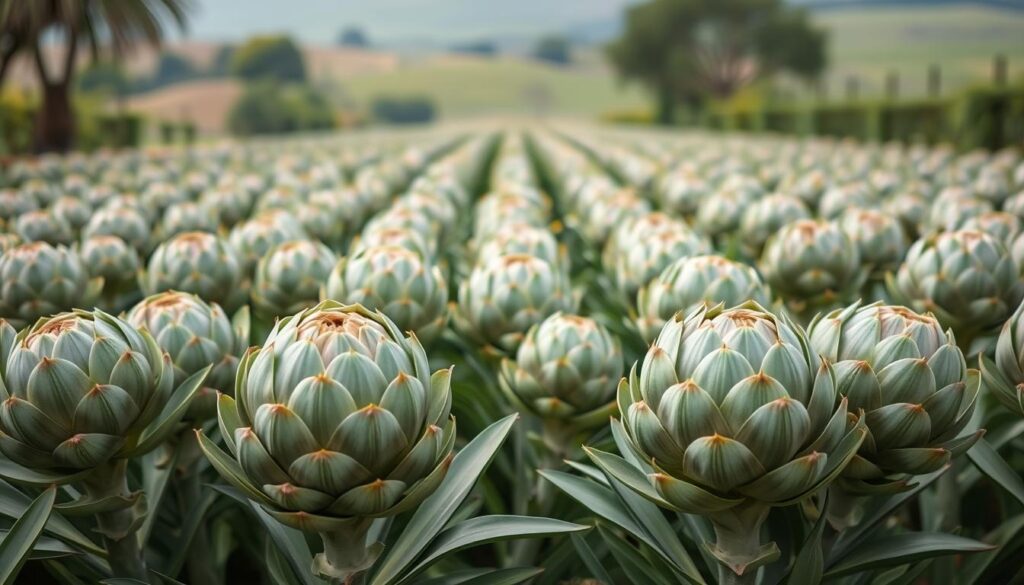
Plants to Avoid Near Artichokes
When cultivating artichokes, it’s essential to recognize the plants to avoid near artichokes. Certain vegetables and herbs can create challenges for your artichoke plants, leading to companion planting pitfalls. By understanding which plants may negatively impact your garden, you can foster a more productive growing environment.
The Impact of Certain Vegetables
Some vegetables present more challenges than benefits when planted near artichokes. For example, corn may overshadow your artichokes and compete for essential nutrients and space, leading to stunted growth. Other vegetables, such as potatoes, can introduce pests and diseases that affect your artichokes, reducing their overall health and yield.
Herbs to Keep at a Distance
When thinking about herbs that don’t thrive with artichokes, rosemary stands out as a plant to avoid. While rosemary is a fragrant herb, its presence may attract pests that negatively impact your artichoke plants. Similarly, sage can compete for nutrients, hampering the growth of your artichokes.
| Plant Type | Reason for Avoidance | Recommended Alternatives |
|---|---|---|
| Corn | Competes for space and nutrients | Beans |
| Potatoes | Can introduce pests and diseases | Basil |
| Rosemary | Attracts harmful pests | Thyme |
| Sage | Competes for nutrients | Chives |
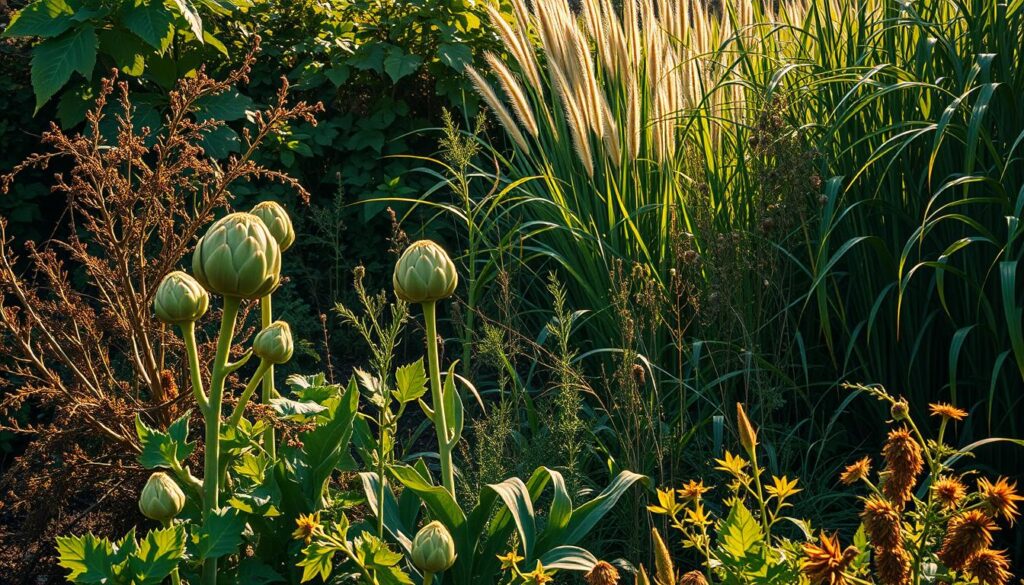
Seasonal Considerations for Companion Planting
Timing plays a vital role in achieving success with your garden, especially when practicing seasonal companion planting. Understanding when to sow artichokes alongside their companions can significantly enhance growth and productivity. This section provides essential spring planting tips and insights into adjusting for fall plant companions.
Spring Planting Tips
Spring serves as the perfect time to start your artichokes and their companion plants. As the days grow longer and temperatures rise, consider the following tips:
- Prepare your soil by enriching it with organic matter to ensure nutrient availability for both artichokes and their companions.
- Sow seeds after the last expected frost to allow for optimal growth conditions.
- Choose companion plants that thrive in the same conditions, such as marigolds or beans, which can enhance the growth of your artichokes.
Adjusting for Fall Companions
As summer transitions into fall, it’s crucial to adapt your planting strategies for fall companions. The cooler temperatures and shorter days can affect growth patterns. Keep these considerations in mind:
- Plant fall companions early enough to allow them to establish before frost hits.
- Select crops that can withstand cooler temperatures, such as kale or certain varieties of beans, which pair well with late-season artichokes.
- Monitor moisture levels, as fall conditions can be drier. Regular watering will support healthy growth during this transition.

Maintenance Tips for Artichoke Gardens
Proper maintenance for artichokes is crucial for a thriving garden. This includes establishing effective watering techniques and a solid fertilization guide for companion plants. By following best practices in these areas, you can ensure your artichokes receive the care they need to flourish.
Watering Best Practices
Artichokes thrive in consistently moist soil, making effective watering techniques essential. Aim for a deep watering schedule of about 2 to 3 times a week. This practice encourages the roots to grow deeply, enhancing drought resistance and overall health of the plants. During particularly hot or dry spells, consider increasing the frequency to maintain adequate soil moisture.
Fertilization Techniques
As heavy feeders, artichokes benefit from regular fertilization. A comprehensive fertilization guide for companion plants highlights the importance of incorporating organic matter into the soil. Use compost or well-rotted manure to enrich the soil, ideally applying this mixture during the early stages of growth. Applying organic fertilizer every 4 to 6 weeks can provide the necessary nutrients, supporting not just the artichokes but also their companion plants in the garden.
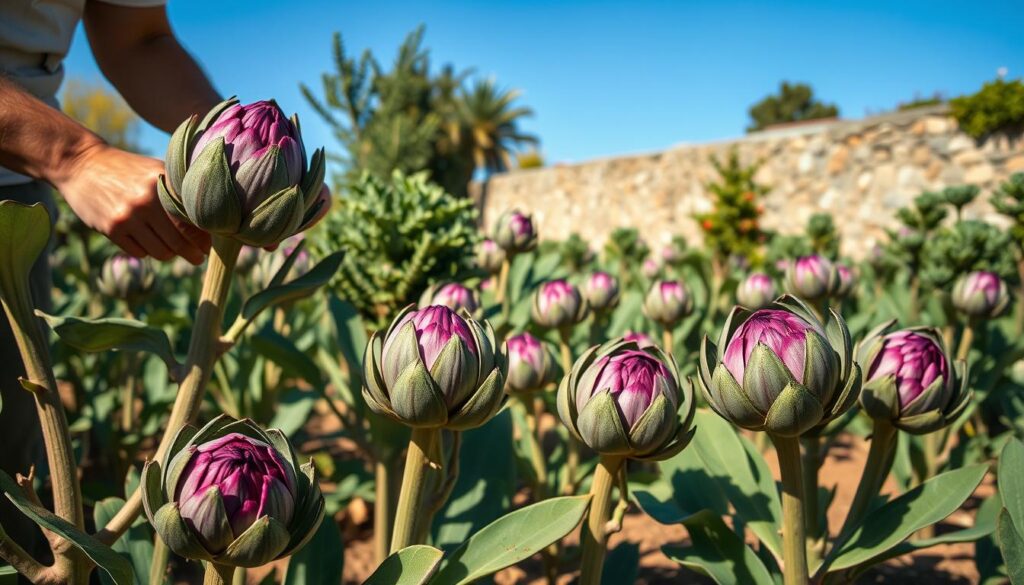
Harvesting Artichokes and Their Companions
Understanding the right time for artichoke harvesting is essential for maximizing your yield. You want to be sure to harvest artichokes while the buds remain tight, which usually occurs in spring or early summer. By being vigilant, you can achieve optimal flavor and texture in your harvest. The timing for harvesting companions plays a significant role in your garden’s efficiency.
When to Harvest Artichokes
The ideal time for harvesting artichokes occurs when the buds are plump and firm but before they start to flower. Usually, this happens in the late spring to early summer months. Regularly checking your artichoke plants allows you to seize the moment for the best quality produce. Staying proactive in artichoke harvesting leads to a more rewarding gardening experience.
Timing for Companion Plant Crops
For effective garden management, you need to understand the timing of companion plant crops. Staggering the planting of your harvesting companions is crucial to ensure a continuous yield over the growing season. This method increases garden efficiency and allows you to enjoy a variety of fresh produce simultaneously. By planning your plantings carefully, you can ensure that your garden remains productive and vibrant throughout the year.
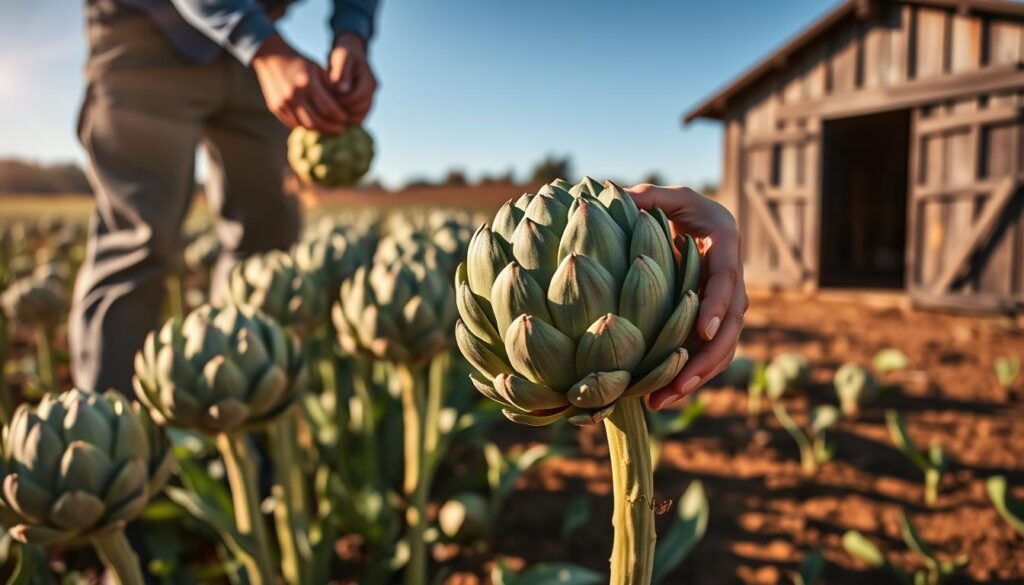
Common Pests and Diseases for Artichokes
Artichokes can fall prey to various challenges, from pesky insects to troublesome diseases. Identifying these common issues early helps maintain the health of your plants. Understanding artichoke pests like aphids and spider mites, along with recognizing common diseases, is crucial for effective management.
Identifying Common Issues
Pests such as aphids and spider mites often target artichokes, leading to wilting leaves and stunted growth. Additionally, diseases like powdery mildew and rust can develop under unfavorable conditions. Keeping a watchful eye on your plants ensures early detection and timely action.
Preventative Measures with Companion Plants
Implementing preventative pest control with companion plants provides an effective strategy to protect your artichokes. For example:
- Marigolds can deter nematodes and repel aphids.
- Mint serves as a natural pest repellent against various insects.
- Basil not only enhances flavor but also dissuades harmful pests.

Creative Ideas for Companion Planting
Innovative gardening solutions can elevate your growing experience, especially when dealing with space limitations. By exploring creative companion planting strategies, you can enhance your artichoke yield while optimizing your garden’s layout.
Vertical Gardening Approaches
Vertical gardening with artichokes presents an exciting opportunity to maximize your growing area. Imagine utilizing trellises or wall-mounted planters to support artichokes. This technique encourages air circulation and reduces the footprint of your plants. Opting for robust companion plants that can grow alongside your artichokes in a vertical setup, such as climbing beans or certain types of herbs, provides added benefits. These companions help deter pests while offering a lush, green backdrop.
Container Planting Techniques
Container growing techniques offer another excellent avenue for those interested in creative companion planting. Artichokes, while large, can thrive in sizable containers. Choose deep pots that allow room for the roots to spread. Combining your artichokes with companion plants in these containers can enhance the overall health and aesthetics of your garden. Consider pairing artichokes with herbs like basil or flowers such as marigolds, which can contribute to pest management and increase biodiversity.

| Technique | Description | Benefits |
|---|---|---|
| Vertical Gardening | Utilizing trellises or wall fixtures for planting artichokes | Maximizes space, improves air circulation, and provides support |
| Container Planting | Using large containers for artichokes and their companions | Easy to manage, allows diverse plant combinations, and enhances garden appearance |
Sustainability and Companion Planting
Incorporating sustainability in gardening practices fosters healthier ecosystems and enhances productivity. Companion planting emerges as a simple yet powerful method to achieve these goals. By selecting plants that mutually benefit each other, you can optimize growth, deter pests, and contribute positively to the environment.
Environmental Benefits of Companion Cultivation
Utilizing companion planting yields numerous environmental benefits. This method promotes biodiversity, enabling a variety of plant species to thrive together. The diversity created through companion cultivation supports local pollinators and beneficial insects, encouraging robust ecosystems. This practice helps maintain natural pest control by fostering a balanced garden environment.
Reducing Chemical Use in Your Garden
Sustainability in gardening often involves reducing chemicals in gardens. By using companion plants strategically, you can significantly minimize reliance on synthetic fertilizers and pesticides. For instance, plants like marigolds and basil deter harmful insects while promoting the health of nearby crops. This natural approach enhances soil quality and reduces the ecological footprint of your gardening practices.
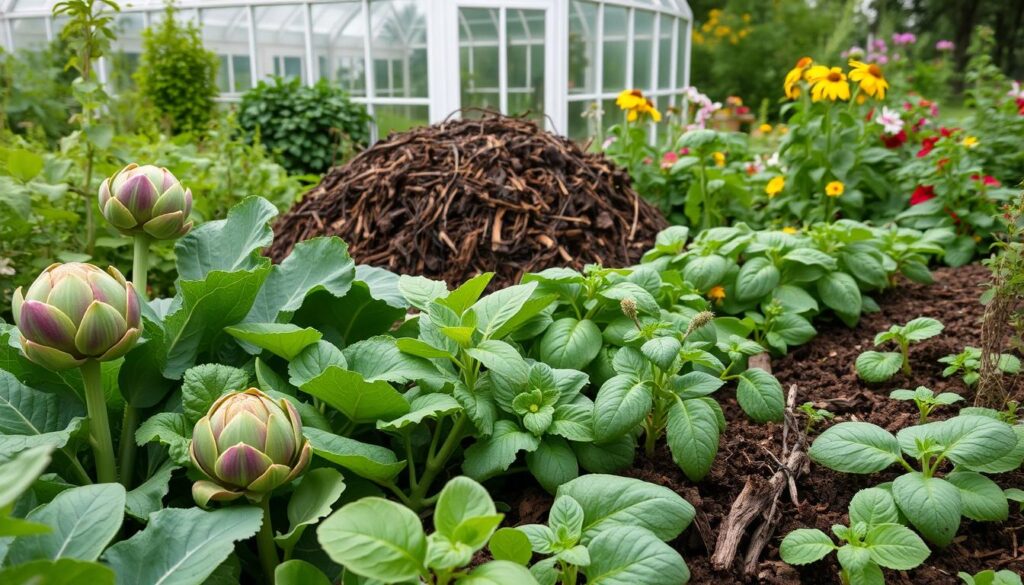
In conclusion, embracing companion planting aligns perfectly with your desire for sustainable practices. By understanding the environmental benefits of companion planting and focusing on reducing chemical use, you can create a thriving, eco-friendly garden that flourishes naturally.
Success Stories: Real-World Companion Planting
Companion planting has gained traction among gardeners seeking effective, sustainable practices in their gardens. Numerous American gardening case studies illustrate how this technique not only enhances the health and yield of artichokes but also fosters a more vibrant ecosystem. Let’s explore some inspiring companion planting success stories that underscore the benefits of this approach.
Case Studies from American Gardens
In various gardens across the United States, gardeners report remarkable success with companion planting strategies. One noteworthy case involved a community garden in California, where planting marigolds alongside artichokes significantly reduced aphid infestations. This reduction improved the health of artichokes and led to a bumper harvest, showcasing the effectiveness of using plants that repel common pests.
Another example comes from a suburban garden in Texas, where beans were integrated into the layout. The nitrogen-fixing capabilities of beans complemented the nutrient needs of artichokes, allowing for lush growth. Gardeners noted that this combination not only produced hearty plants but also encouraged biodiversity, which is essential for balanced ecosystems.
Lessons Learned and Key Takeaways
These American gardening case studies reveal essential lessons from companion planting. Here are some key takeaways:
- Using pest-repelling flowers like marigolds can protect artichokes from harmful insects.
- Integrating nitrogen-fixing plants, such as beans, supports the overall health and yield of artichokes.
- Experimentation can lead to unique and beneficial combinations; what works in one garden might inspire innovation in another.

Conclusion: Getting the Most from Your Artichoke Garden
As you wrap up your journey through companion planting with artichokes, it’s essential to reflect on the myriad advantages it offers. Utilizing companion planting can lead to healthier plants, increased yields, and a more vibrant garden ecosystem. Whether it’s through fostering beneficial relationships between plants like marigolds and your artichokes or optimizing soil conditions, the companion planting benefits recap highlights how these practices can elevate your gardening experience.
Don’t hesitate to experiment as you cultivate your artichoke garden! By encouraging garden experimentation, you can discover what combinations work best for you. Each season presents a new opportunity to try different companion plants, which might surprise you with their results. Personal observations and adaptations will undoubtedly create a more enriching environment for both you and your plants, maximizing your artichoke garden’s potential like never before.
Your artichoke gardening adventure is just the beginning. Engaging closely with your plants and the natural interactions that develop between them can lead to delightful outcomes. Keep experimenting, stay curious, and enjoy the journey of growing your own delicious artichokes alongside their perfect companions.
